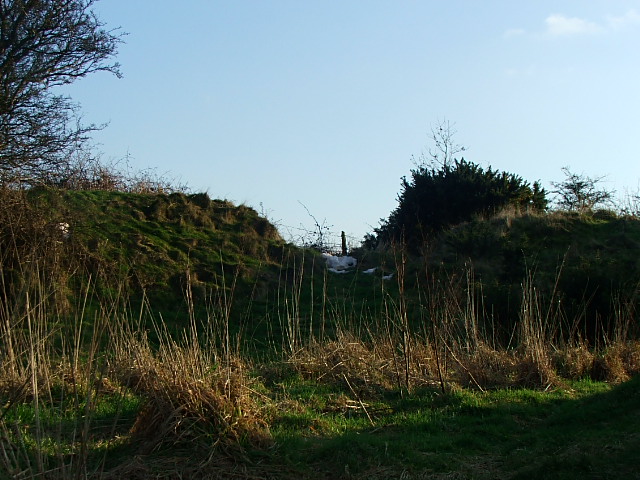
The trees have gone from the low square building, but the grasses were high and the tunnel that so perplexed my last trip here was possibly hidden beneath much chopped wood. Drat.

The trees have gone from the low square building, but the grasses were high and the tunnel that so perplexed my last trip here was possibly hidden beneath much chopped wood. Drat.

Information board.

The newly recreated eastern entrance, barely three years old and it’s already falling apart.

Eric sits in the north entrance and ponders his lot in life.

Looking north-ish to the lesser preserved part of the fort.

Looking just east of north to the best preserved part of the fort.

Not sure what this is, entry to some forbidden underworld, probably.

Looking out the recreated entrance.

Not sure how those people got past us but they are inspecting the renewed entrance.

The fort on it’s hill as seen from Delamere railway station.










THE Habitats and Hillforts project has been staging a four week archaeological dig at Eddisbury Hill Iron Age Hillfort.
The intention is to re-excavate trenches through the ramparts and one of the entrances that were originally opened up between 1936 and 1938 in order to expose the sections and recover charcoal samples for radiocarbon dating.
Details at iccheshireonline:
Access was easy but i was unsure whether i was trespassing ,there was barbed wire all around it although a small lane led straight into it.in the south-east corner was what seemed like the outline of a building and some strange tunnel ,just big enough to crawl through ,my gut feeling was it was not iron age ,maybe medieval.The hill forts entrance is quite big and the ditch and bank at least 8ft tall ,the view is wonderful the whole of Delamere forest and in the distance the cooling towers of Merseyside(ugh again)
The lady [in this narrative] was no less than a princess and queen. She lived as long ago as Saxon times in a city on Eddisbury Hill. The hill can be seen to this day to the south of Delamere Station and only a mile away.
Ethelfleda, for that is the lady’s name (now reduced to Ethel), was a daughter of Alfred the Great, and she ruled over the kingdom of Mercia right up to the banks of the Mersey. She married Ethelred (not the Ethelred of history). [...] She ruled the city of Eddisbury firmly and well. But after she died, it fell into all sorts of lawlessness and disorder, so that it was destroyed, and not one stone stands upon another. But broad lines, marked by the turf in darker green where the damp is arrested, still shew the presence of foundations, and there is, or was, an old draw-well, partly filled up and fringed with thorns and briers.
[...] Why the spirit of the lady should haunt a woodland brook more than a mile away, and why the turbulent souls of the departed city should stream down the hill at night (according to the testimony of a well-known farmer, long since gone to his rest), seems purposeless and inconceivable. does the lady go to meet anyone, and are the turbulent souls afflicted with insatiable thurst?
“Dinna thee goo thear – there’s a buggin thear,” said an elderly native, as I struck into the forest on a summer night, along the well-known Buggin Walk, by a woodland brook! Turning back to the old gentleman for particulars of identification I was told the lady was of commanding presence, with long, golden tresses – dressed, of course, in a white costume, but not of the prevailing fashion – that the lady seemed to be expecting someone – in short, this was the Lady Ethelfleda! [...] J. A.
From the Cheshire Observer, 6th March 1915.
About the year 900 [..], Ethelfleda built a town called Eddisbury, in the very heart or “chamber” of the forest, which soon became populous and famous for the happy life led by its inhabitants. Though all vestige of this once happy town has now disappeared, yet its name remains, and its site in the chamber of the forest can still be pointed out.
And certainly a finer site the Lady Ethelfleda could not have chosen. It was placed on a gentle rising ground in the centre of the forest, overlooking finely wooded vales and eminences on every side. A little brook rippled past through a small valley, and the old Roman road wound its way round the eminence on which the town was built.
This antique Saxon lady seems to have had a strange passion for building, as we are told she not only built this town, but that she also built fortresses at Bramsbury, Bridgenorth, Tamworth and Stafford, and most probably would have built many more had she not died at Tamworth in 922.
books.google.co.uk/books?id=sN0wjxyotFwC&pg=PA214
From ‘English Forests and Forest Trees’ (1853). Information about Ethelfleda largely comes from a short Anglo Saxon document called the ‘Mercian Register’ which covers the years 902-24.











